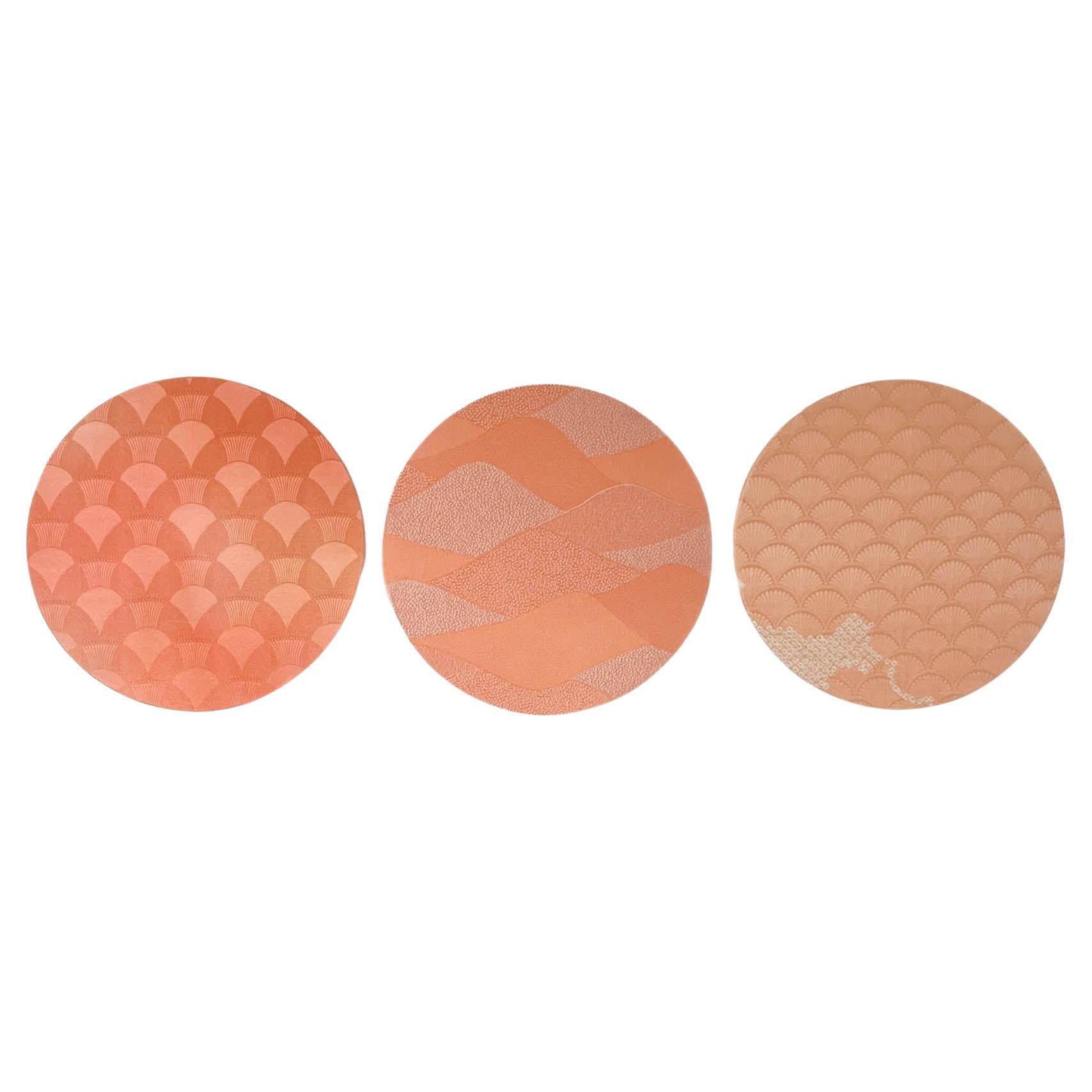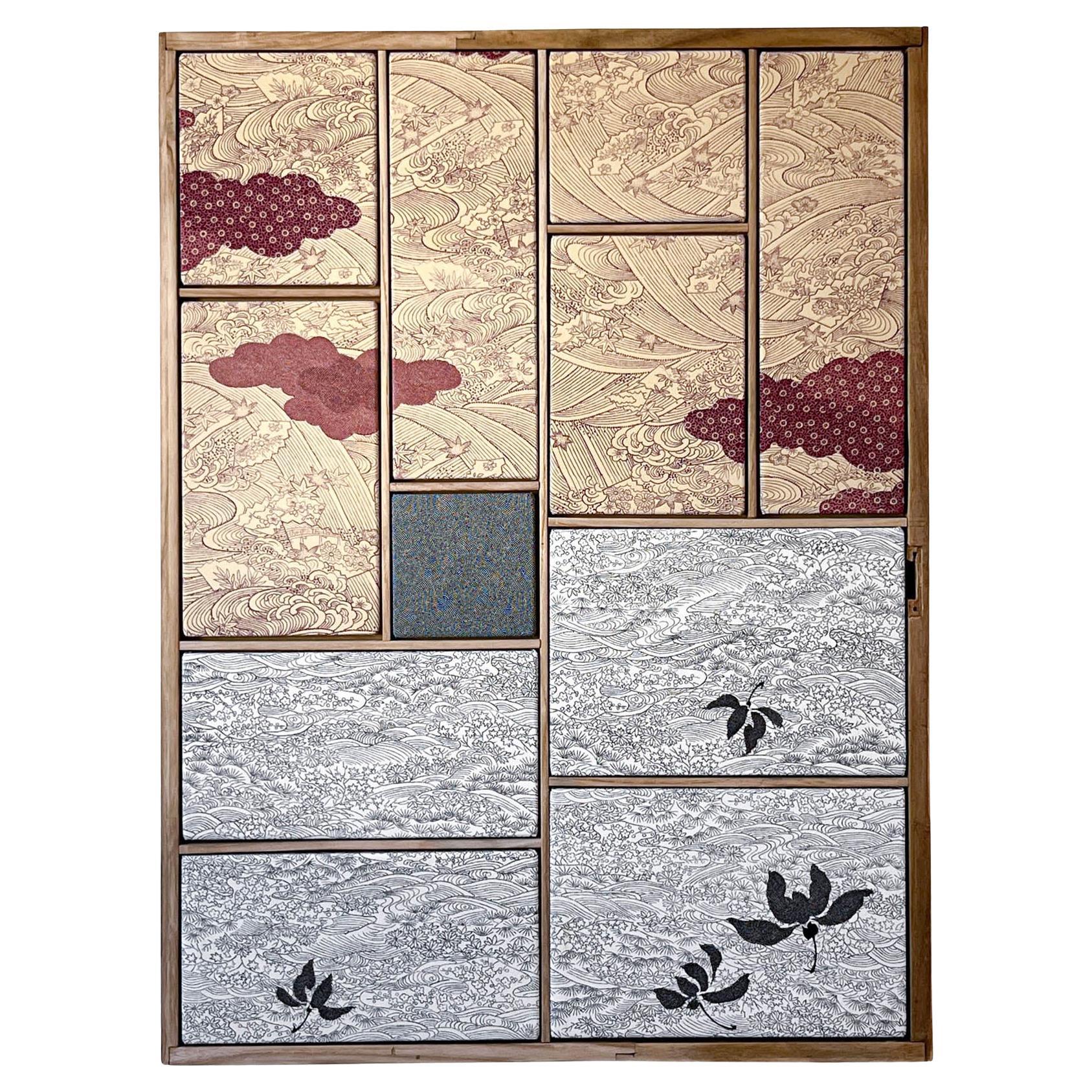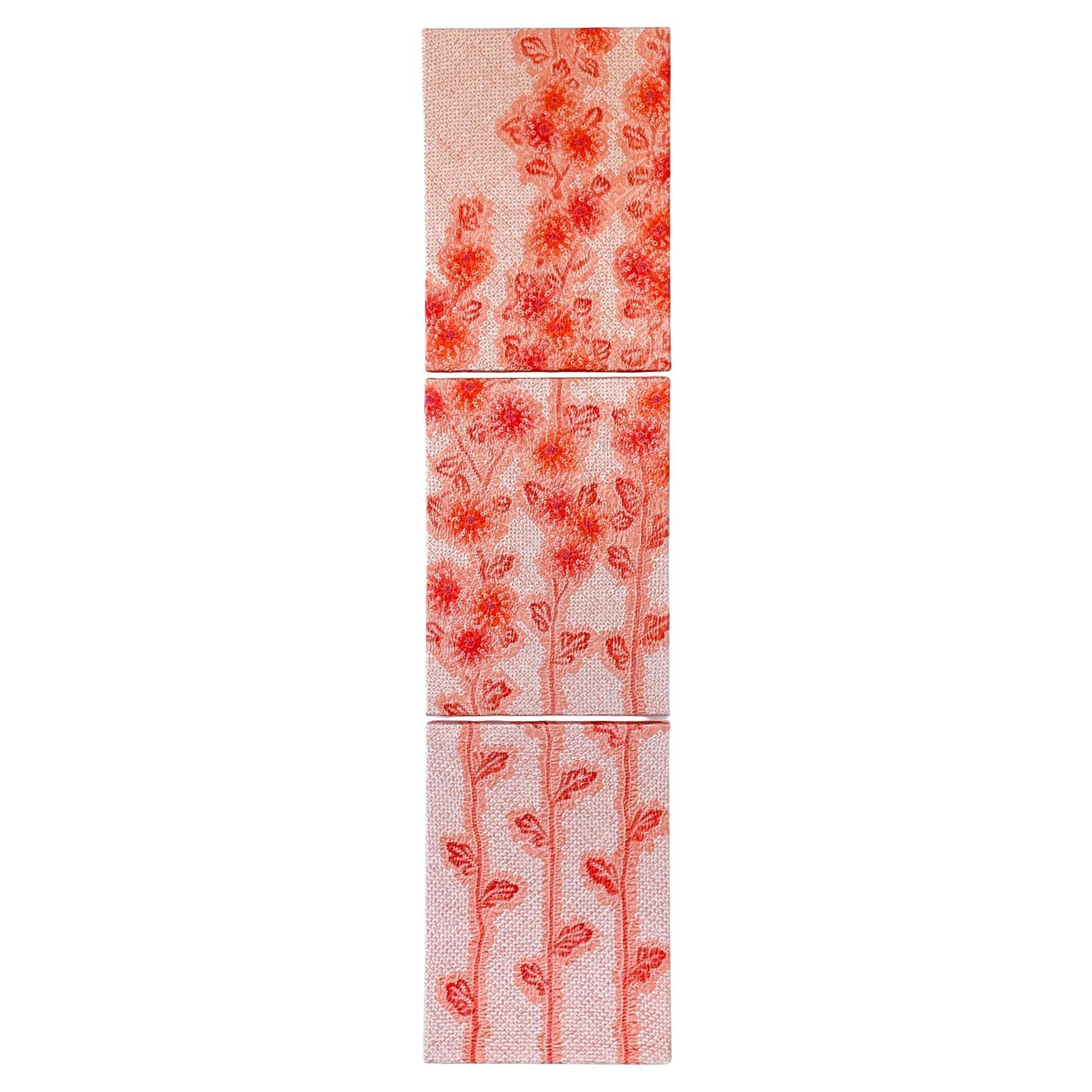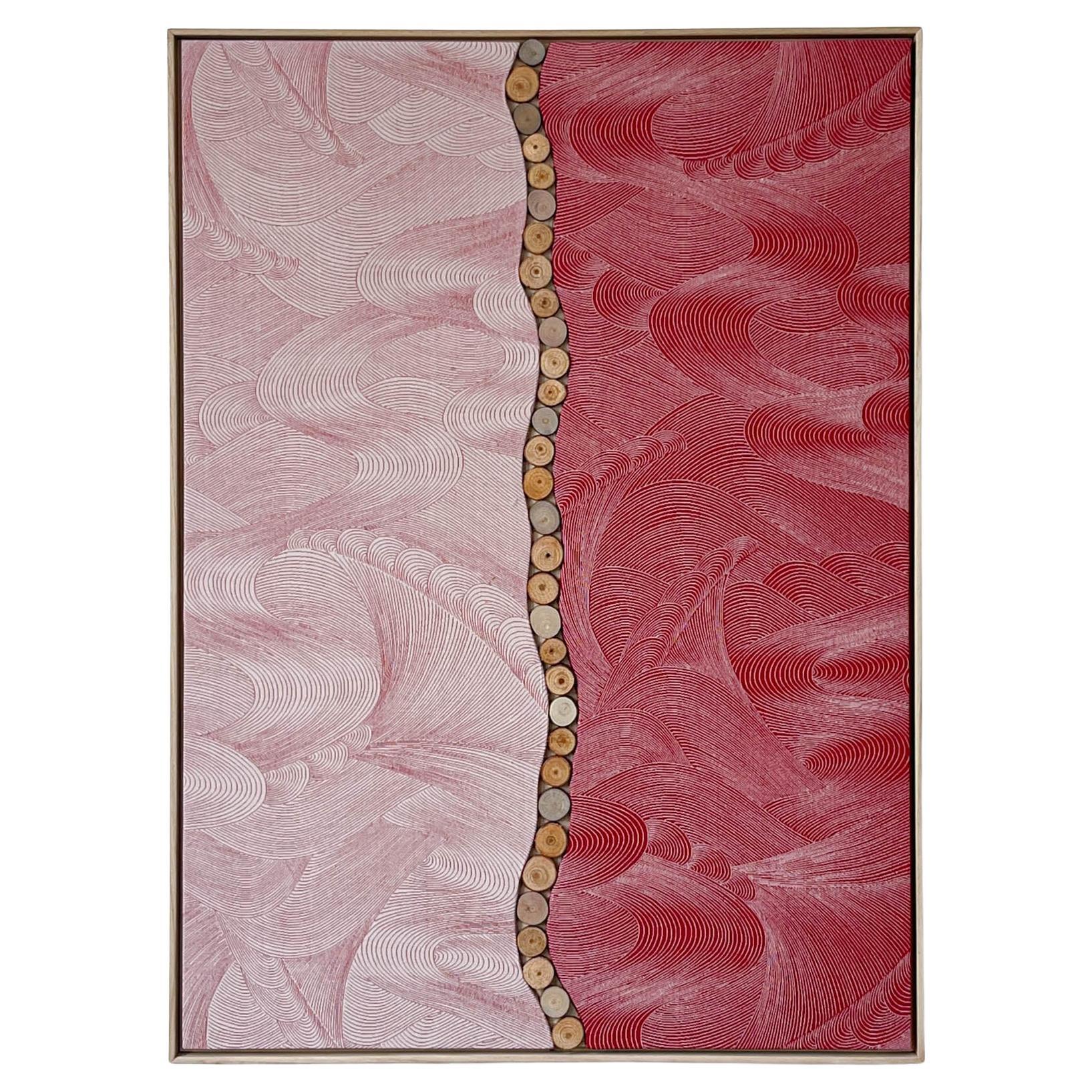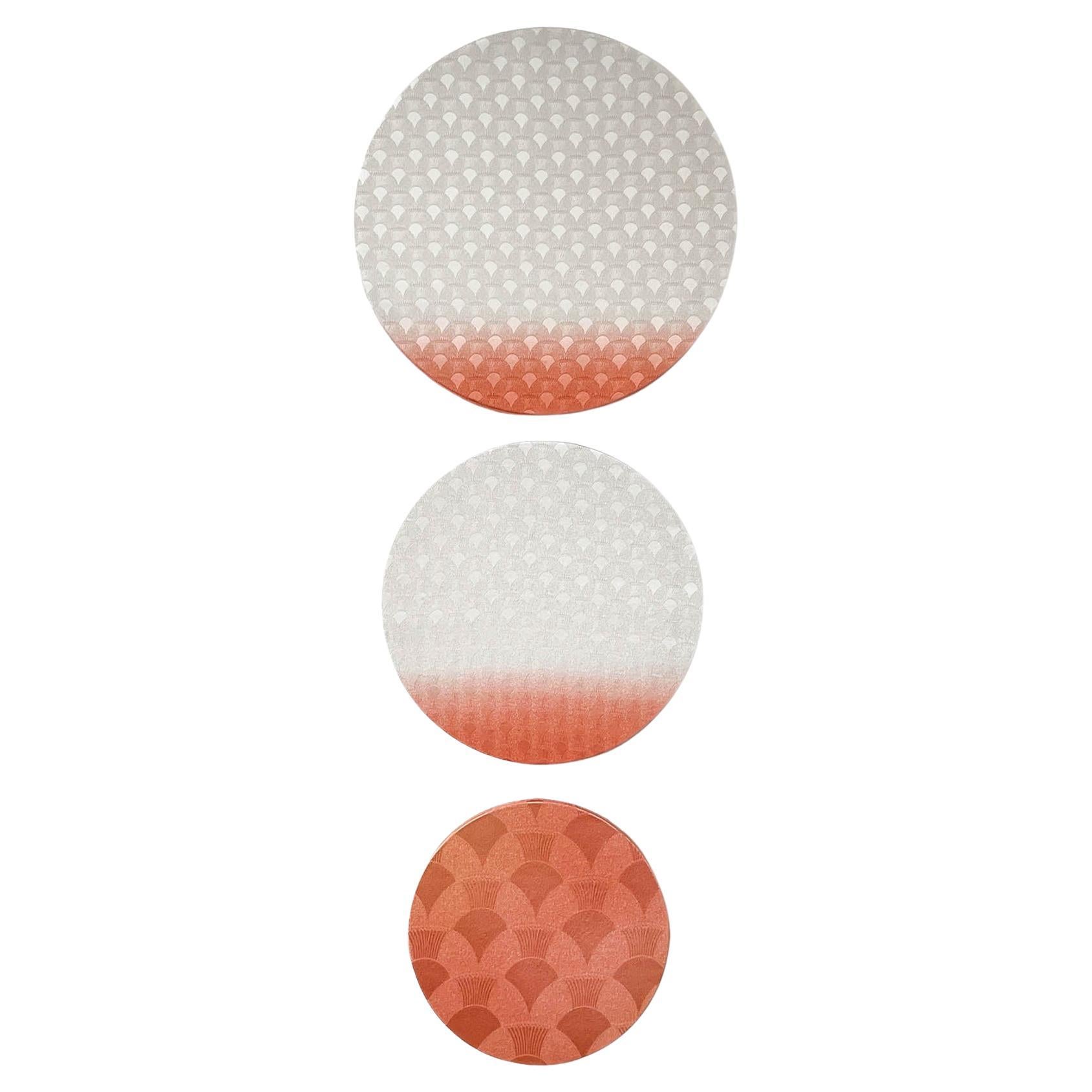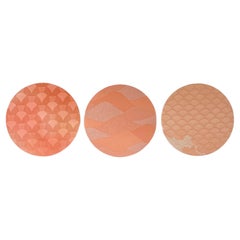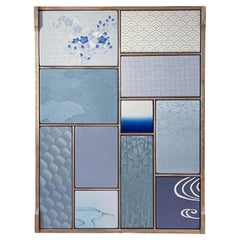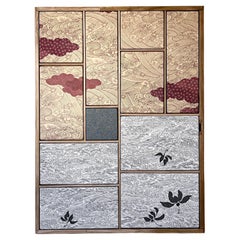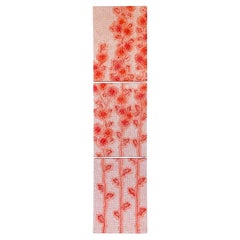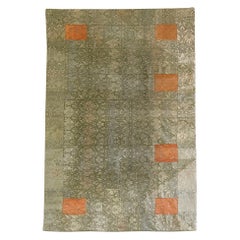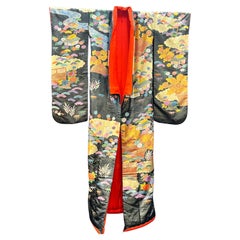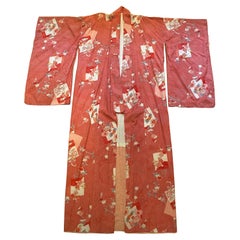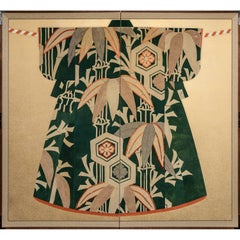Items Similar to Antique kimono textile art " Kobachi ~ Coral Collection ~ " by ikasu Pink, Japan
Video Loading
Want more images or videos?
Request additional images or videos from the seller
1 of 20
Antique kimono textile art " Kobachi ~ Coral Collection ~ " by ikasu Pink, Japan
$3,000
£2,293.66
€2,641.83
CA$4,203.92
A$4,693.28
CHF 2,459.21
MX$57,450.37
NOK 31,231.98
SEK 29,447.79
DKK 19,716.27
About the Item
This work is inspired by the coral color palette, and is framed in paulownia wood originally used for a kimono chest-of-drawers.
In this artwork, the aim was to capture the wide palette of coral color commonly used in antique kimono. Traditional Japanese culture, represented by the kimono, and wood, an integral element of Japanese craftsmanship, were used to bring this vision to life.
I used pieces of kimono, haori and kimono lining that could no longer be used as clothing and kiritansu chest-of-drawers that would normally be discarded to create the ultimate upcycled piece.
The artwork is called "kobachi". Kobachi is a style of serving in Japanese cuisine, when small plates are positioned in a special way to satisfy both mouth and eyes.
<< Explanation and meaning of pattern and colors >>
Coral color is as special in Japan as it is in western culture.
This piece is impressive with its refreshing highlight of blue standing out against a gradient of pale coral color.
"Coral color" is a bright red color reminiscent of the axis of red coral, which is also expressed in modern times as salmon pink. It is believed that this color name originated from the colors of red coral or peach-colored coral ("Sango 珊瑚" in Japanese). In the Edo period, coral was popular as a decorative item such as hairpins and beads. Coral is mentioned as one of the "Seven Treasures" in Buddhist scriptures. Crushed coral was also used in Japanese paintings as a pigment introduced from China.
A lighter, slightly yellowish pink is called "akakōiro 赤香色" (literally "red incense color"). "Ko 香" means "fragrance", and "Kōiro" refers to a color extracted by boiling fragrant woods such as cloves. It was also called "awaki kō 淡き香" (pale incense color). The stronger red tinted one is called "akakōiro." Because cloves were very expensive, dyeing with safflower and gardenia was widely practiced.
The deep red in the lower left is called "akaneiro 茜色" (madder red). It refers to a subdued red with a slight yellowish tinge, and it is known for being mentioned in the Manyoshu poems, describing the evening sky, among other uses. The name of the color comes from the plant "akane 茜" (madder) which contains a red dye. The red color produced from its roots is said to be one of the oldest dyes derived from plants alongside indigo blue.
The impressive light blue in the center is called "mihanada-iro 水縹色" (literally "water light blue"). It refers to a light shade of indigo dye, a bright blue color. It can also be read as "mizuhanada" and its name can be found in the Manyoshu poems as well. It is the old color name of modern "mizuiro 水色" (water color) and it was used interchangeably until around the medieval period. However, by the Edo period (17th cent.), "mizuiro" became the mainstream term, which continues to this day.
In this work, coral is represented in different shades and tones to show the fascinating Japanese traditional dying techniques.
<< About the frame >>
Kiritansu - chest-of-drawers for kimono, is traditionally made from paulownia wood, a uniquely Japanese material closely tied to the world of kimonos.
Paulownia wood is known as the lightest wood in Japan, prased for its natural luster, resistance to moisture, and resilience against cracking. Since ancient times, it has been used in crafting furniture, chests, and musical instruments.
During the Edo period, it became customary to store cherished kimonos in paulownia chests, which offered fire resistance and protection from moisture and insects.
Traditionally, when a daughter was born, a paulownia tree would be planted. Upon her marriage, the tree would be cut down, and the wood would be used to craft a chest for her as a wedding gift.
Following the Ansei Earthquake during the late Edo period in 1855, paulownia chests gained popularity due to their ability to withstand fires and even float in water, thereby safeguarding their contents during floods.
I use antique kiritansu that can’t be used as furniture anymore to create basis and frames for my works. It adds them even more authentic atmosphere of traditional wabisabi spirit. Can you feel it?
- Creator:Kimono ikasu (Artist)
- Dimensions:Height: 33.47 in (85 cm)Width: 24.81 in (63 cm)Depth: 1.97 in (5 cm)
- Style:Japonisme (In the Style Of)
- Materials and Techniques:
- Place of Origin:
- Period:
- Date of Manufacture:1920
- Condition:
- Seller Location:Setagaya City, JP
- Reference Number:1stDibs: LU10079243303652
About the Seller
No Reviews Yet
Vetted Professional Seller
Every seller passes strict standards for authenticity and reliability
1stDibs seller since 2024
- ShippingRetrieving quote...Shipping from: Setagaya City, Japan
- Return Policy
Authenticity Guarantee
In the unlikely event there’s an issue with an item’s authenticity, contact us within 1 year for a full refund. DetailsMoney-Back Guarantee
If your item is not as described, is damaged in transit, or does not arrive, contact us within 7 days for a full refund. Details24-Hour Cancellation
You have a 24-hour grace period in which to reconsider your purchase, with no questions asked.Vetted Professional Sellers
Our world-class sellers must adhere to strict standards for service and quality, maintaining the integrity of our listings.Price-Match Guarantee
If you find that a seller listed the same item for a lower price elsewhere, we’ll match it.Trusted Global Delivery
Our best-in-class carrier network provides specialized shipping options worldwide, including custom delivery.More From This Seller
View AllVintage kimono textile art "On Coral Waves ~Everlasting~" by ikasu Pink, Japan
By Kimono ikasu
Located in Setagaya City, JP
<< About this canvas >>
This kimono canvas set of three pieces portrays mountains surrounded by the sea. While each of the three pieces is crafted from different kimonos, they all s...
Category
Vintage 1970s Japanese Japonisme Paintings and Screens
Materials
Silk, Canvas
Antique kimono textile art " Kobachi ~Marine Collection~ " by ikasu Blue, Japan
By Kimono ikasu
Located in Setagaya City, JP
This work is inspired by the blue color palette, and is framed in paulownia wood originally used for a kimono chest-of-drawers.
In this artwork, the aim was to capture the wide pale...
Category
Vintage 1920s Japanese Japonisme Paintings and Screens
Materials
Silk, Wood
Antique kimono textile art " Waves and clouds ~Eternity~ " by ikasu Beige, Japan
By Kimono ikasu
Located in Setagaya City, JP
This work is inspired by traditional hand-dying technique edo-komon, and is framed in paulownia wood originally used for a kimono chest-of-drawers.
It is elegantly framed with paulo...
Category
Vintage 1920s Japanese Japonisme Paintings and Screens
Materials
Silk, Wood
Vintage kimono textile art " Growing ~ Longevity ~ " by ikasu Pink, Japan
By Kimono ikasu
Located in Setagaya City, JP
<< About this canvas >>
This set is a depiction of a tall chrysanthemum stem, entirely dyed in a traditional shibori technique.
<< Period / Story >>
The haori featured in this canvas was created and used during the late Showa period (1960-80ies).
<< Explanation and meaning of pattern and colors >>
A charming chrysanthemum flowers all around a stem seem to reach the heavens.
The chrysanthemum flower, which retains its vitality long after being cut, symbolizes longevity, purification from malevolent spirits, and good fortune. In ancient times, during the Kamakura period (1185-1333), emperors loved the chrysanthemum pattern, and it remains the most prestigious flower and the emblem of the Japanese imperial family...
Category
Vintage 1970s Japanese Japonisme Paintings and Screens
Materials
Canvas, Silk
Vintage kimono textile art "Sunset Timelapse ~Ephemerality~" by ikasu Red, Japan
By Kimono ikasu
Located in Setagaya City, JP
The art piece uses two sides - front and reverse - of the same kimono, to show beautiful sea surrounding Japan, in hues and in late sunset, as a timelapse.
The frame for this work is made of paulownia wood taken from antique Kiritansu - chest-of-drawers for kimono.
I use antique kiritansu that can’t be used as furniture anymore to create basis and frames for my works. It adds them even more authentic atmosphere of traditional wabisabi spirit. Can you feel it?
<< Period / Story >>
The kimono used in this piece was originally crafted during Showa period (around 1960ies).
<< Explanation and meaning of pattern and colors >>
Sea waves, depicted in two color variations here, are a symbol of transience and Impermanence in Japanese culture. The ebb and flow of the tides, the ever-changing currents, and the relentless motion of the waves serve as reminders of the fleeting nature of life. This artwork featuring the sea convey themes of impermanence, reminding viewers to cherish the present moment and appreciate the beauty of life's fleeting moments.
The theme of impermanence is strengthen by two colors of the sea - the lighter in early hues and the darker when the sun is just about to set in the sea.
<< About the frame >>
This artwork frame is crafted from paulownia wood, a uniquely Japanese material closely tied to the world of kimonos, and it serves to convey the refined beauty of Japanese nature.
Paulownia wood is known as the lightest wood in Japan, prased for its natural luster, resistance to moisture, and resilience against cracking. Since ancient times, it has been used in crafting furniture, chests, and musical instruments.
Paulownia wood is closely linked to kimono culture. During the Edo period (17th cent.~), it became customary to store cherished kimonos in paulownia chests...
Category
Vintage 1960s Japanese Japonisme Paintings and Screens
Materials
Silk, Wood
Vintage kimono textile art " Plum Gradation " by ikasu Pink, White, Japan
By Kimono ikasu
Located in Setagaya City, JP
This canvas featuring a plum color gradient kimono showcases a unique decorative variation of the popular seigaiha (青海波) sea waves pattern.
The artwork got a Mr. & Mrs. Abe Arts & Cu...
Category
Vintage 1980s Japanese Japonisme Paintings and Screens
Materials
Canvas, Silk
You May Also Like
Antique Japanese Brocade Monk's Robe Kesa Meiji Period
Located in Atlanta, GA
A Japanese Kesa (Monk's Vestment) made from thirteen columns of patchworks of shimmering woven brocades. The elaborate motifs feature repetitive elaborat...
Category
Antique Late 19th Century Japanese Meiji Textiles
Materials
Brocade, Silk
Vintage Hand-Painted Japanese Wedding Kimono
Located in Fort Washington, MD
Stunning Japanese Wedding Kimono, hand painted with exceptional details in rich warm colores
Has a red silk interior, wooden rod is NOT included
An inc...
Category
Mid-20th Century Japanese Japonisme Textiles
Materials
Silk
Antique Japanese Silk Kimono
Located in Bedford Hills, NY
Beautiful antique Japanese silk Kimono.
Category
Early 20th Century Japanese Anglo-Japanese Textiles
Materials
Silk
Japanese Two Panel Screen: Antique Kimono Fabric Mounted on Screen
Located in Hudson, NY
Japanese Two Panel Screen: Late Nineteenth Century Kimono Fabric Mounted on Early Twentieth Century Screen. In the Heian period (eighth century to the twelfth century), noblemen wou...
Category
Early 20th Century Japanese Meiji Paintings and Screens
Materials
Silk, Wood, Paper
Japanese Silk Haori Jacket Red-Orange Hanaguruma 1970s
Located in Paris, FR
This is a silk jacket which was made in Japan.
It was made in Showa era around 1970s.
The haori is a traditional Japanese hip- or thigh-length jacket worn over a kimono. Resembling ...
Category
Late 20th Century Japanese Showa Antiquities
Materials
Silk
Japanese silk kimono pink grey with patterns
Located in Paris, FR
This is a silk kimono which was made in Showa era around 1970s in Japan.
The kimono is a traditional Japanese garment and the national dress of Japan. The kimono is a wrapped-front garment with square sleeves and a rectangular body, and is worn left side wrapped over right, unless the wearer is deceased. The kimono is traditionally worn with a broad sash, called an obi, and is commonly worn with accessories such as zōri sandals and tabi socks...
Category
Late 20th Century Japanese Showa Antiquities
Materials
Silk
